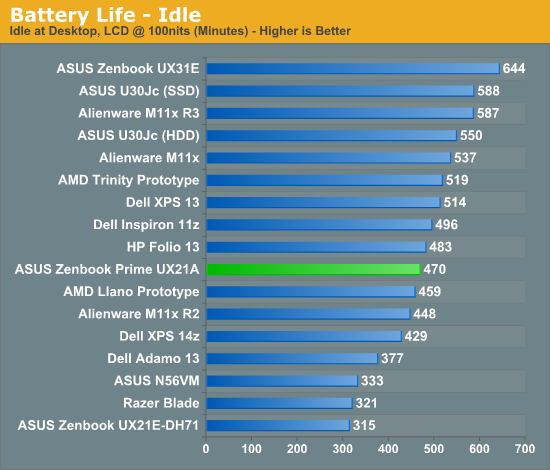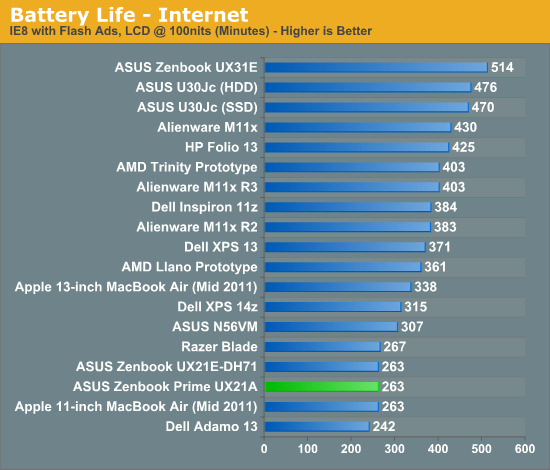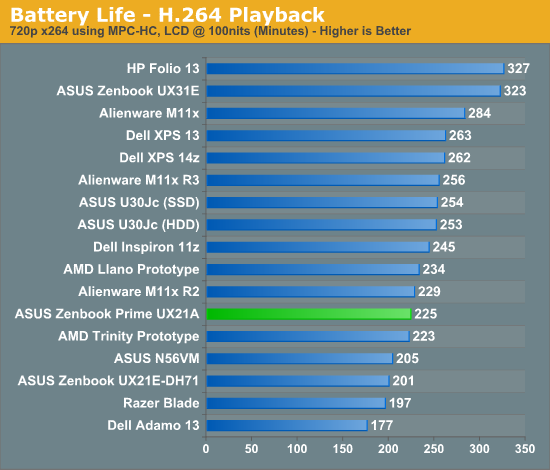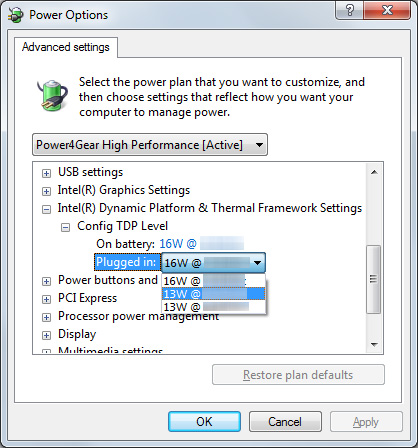ASUS Zenbook Prime (UX21A) Review: The First of the 2nd Gen Ultrabooks
by Anand Lal Shimpi on May 22, 2012 2:46 PM EST- Posted in
- Laptops
- CPUs
- Asus
- Ivy Bridge
- Zenbook
- Zenbook Prime
- Ultrabook
- Notebooks
Battery Life
Generally speaking, the 11-inch Zenbook Prime delivers about the same amount of battery life as its predecessor. For some reason we're able to hit much longer idle battery life on the Prime than the original Zenbook although I'm still trying to find out why. There's also an 11% improvement in our x264 playback test, but on average I'd expect to see similar battery life to the Sandy Bridge model - just with better performance. Note that these results also come despite the fact that ASUS is driving a much higher resolution, and presumably higher power, display than the original Zenbook.



The Zenbook Prime bucks the trend Jarred saw with the first Ivy Bridge notebook review where battery life took a small step backwards. These results bode well for future Ivy Bridge notebooks and Ultrabooks. It still remains to be seen if Intel's 22nm process will actually give us a battery life advantage in any notebook compared to its predecessor. It's possible that we are seeing some of the benefits of 22nm here already and they are simply offset by the more power hungry display. With the move to 22nm Intel should have a better hold on active power and leakage, but it's always possible that we'll have to wait until Haswell for the process to really be exploited.
Just like last time, ASUS has a couple of widgets to quickly change between power settings. The instant on widget lets you switch between suspend to RAM and suspend to disk modes. The former is expected to deliver up to 2 weeks of standby battery life, while the latter can push up to 150 days. I didn't have the time to test these claims (life is short, I draw the line at spending it testing claims of 150 day standby battery life). ASUS once again includes a counter that estimates how long your system will last in either mode based on current charge levels and power usage.
The next widget is a quick tool to let you switch between high performance and battery saver Power4Gear power profiles. You can customize these profiles via the Windows control panel, but it's nice to have a button on the desktop that lets you quickly switch between them.
Configurable TDP
One feature of Ivy Bridge that we haven't been able to test until now is configurable TDP. While most Ultrabook CPUs ship with a 17W TDP, that's mostly an arbitrary thermal/power rating. If an OEM wants to design a chassis that can only accept a 13W part it previously had to hope that Intel would make such a thing. Alternatively, the OEM could underclock/undervolt a 17W chip on their own and hope to mimic Intel's validation and deliver a 13W configuration of their own. The former requires that a significant number of OEMs demand the part, while the latter is just too risky for the larger OEMs (get too aggressive on the undervolting side and end up with a bunch of unstable systems). The solution Intel proposed with Ivy Bridge is configurable TDP. For Ultrabooks this means you can set a 17W part to 13W.

Currently the setting is hidden away in Windows 7's power management settings. Once again I've had to censor the clock speeds here due to Intel's Ultrabook embargo:
You can map the 13W settings to the battery saver profile and then, at the click of a button, have a 13W Zenbook Prime instead of a 17W model. The difference in performance isn't significant however:
| ASUS Zenbook Prime Configurable TDP Performance - Cinebench 11.5 (Multithreaded) | |||||||
| 16W - Max Freq | 13W - Mid Freq | 13W - Lowest Freq | |||||
| ASUS Zenbook Prime UX21A | 2.79 | 2.67 | 2.67 | ||||
I'm still running battery life tests to quantify the impact on power consumption, but it's conceptually a neat thing to see in action finally. I suspect configurable TDP is going to play a major role with Haswell and convertible/dockable Ultrabook-tablet hybrids.
Thermals and Noise
As with most high performance notebooks that are this thin, cooling is difficult. Under load the fans in the Zenbook Prime are definitely audible, but in general ASUS does a better job cooling everything inside the Zenbook Prime than Apple does in the MacBook Air. I suspect much of this boils down to how aggressive Apple is about keeping fan speed/noise down compared to ASUS' desire to maintain a certain temperature level inside the chassis.










192 Comments
View All Comments
JarredWalton - Wednesday, May 23, 2012 - link
Possibly, though it's NVIDIA hardware and I think GT 620M is just recycled GT 525M or something (Fermi GF108), so it can't do all three. However, it might be able to do internal on the IGP and two external on discrete? Somehow I doubt it, though; the only laptops I've ever seen running more than two simultaneous panels are using AMD GPUs.rosege - Thursday, May 24, 2012 - link
not sure how you count your panels but I have 2 external displays plus the laptop display running on an old X301using a usb to dvi connector for the second external display - you couldnt use it for anything too serious but for general office apps its fine
Penti - Thursday, May 24, 2012 - link
Dell XPS 13 with Ivy Bridge? HP Elitebooks (Elitebook Folio?) with Ivy Bridge? Report back sometime :)We won't find out until later in June I guess.
amalinov - Wednesday, May 23, 2012 - link
Actually there is a way to have what 1ceTr0n wants and keep the ultrasleek design:- fully implemented (micro-)HDMI - that includes CEC and Ethernet, which are optional in the HDMI spec (for CEC you need to add a very small chip - until Intel/AMD/Nvidia start implementing CEC in the GPUs; for Ethernet you need your standard laptop Ethernet controller - Intel, Broadcom or whatever; then you need only a cheep passive cable to use Ethernet)
If I were in ASUS place I would have done also the following about ports:
- fully implemented mini-DisplayPort (instead of the mini-VGA) - that includes CEC and USB2.0 (for CEC you need to add a very small chip - until Intel/AMD/Nvidia start implementing CEC in the GPUs; for USB - just redirect wires from the chipset; USB in Displayport comes in handy for single cable to monitors with integrated USB hubs/cameras, also it can be converted to one additional standard USB port by the use of cheap passive cable - for devices tolerating 3.3V or having their own power supply - such as hubs) - and Thunderbolt as option for 13" premium models
- USB3.0/eSATAp600 combo ports (for the forum skeptics - http://www.delock.de/produkte/F_246_intern_61862/m... is an example of such port) supporting USB Battery Charging 1.2 (7.5W over standard cable) and draft USB Power Delivery (100W over new type of cable) - and remove the power input port (the laptop will be charged by one of the USB PD ports - just like phones are charged by micro-USB currently) - more space for SD card reader or other ports/LEDs/wireless switches
Wireless interfaces I would've added:
- Bluetooth 4.0+HS (over WiFi PHY)+LE (over WiBree PHY)
- NFC
- FM radio with RDS and internal antenna - receiver and transmitter
Options for premium models:
- GPS/GLONASS/Augumentation satellites support; accelerometers, gyroscopes, magnetometer, altimeter - for inertial navigation indoors and other locations with weak satellite signal
- 2G/3G/LTE
- DVB-T/T2/H/SH (or equivalent US TV broadcasts) tuner with internal antenna
Premium models power adapter with:
- additional USB3.0 BatteryCharging/PowerDelivery ports (when the laptop is disconnected those will only provide power to other USB-powered devices; when the laptop-or-another-USB-host is connected a USB3.0 hub in the power adapter will provide also USB connectivity to the connected devices (like a docking station); switch to choose whether the power adapter USB ports should remain powered when no USB host is connected
- maybe integrate the bundled USB-to-Ethernet converter here (but this is kind of redundant if the HDMI port is of the Ethernet-enabled variety)
- maybe also add a USB audio controler providing 6 jack analog jacks (for 7.1 output, line-in, microphone)
Other additions (some of which not very realistic for the time being):
- Anti-glare matte display (if it isn't already of this type)
- Fanless design (if it isn't already of this type)
- Multi-touch screen with support for 10 fingers+2 palm-restings and maybe stylos/handwriting
- Touchpad occupying the whole surface below the keyboard with support for 10 fingers+2 palm-restings and stylos/handwriting; maybe even a second screen (for customizable buttons, auxiliary information like level map, etc.)
- two multi-megapixel back cameras with autofocus, xenon flash, night-mode video illumination, etc. (just like high end phone) for stereoscopic pictures and 2x1080p60 (3D) video
- two 1080p60 front cameras (for 3D mode) - either with separate illumination or utilizing the keyboard illumination
- integrated Kinect-like gesture recognition system with sensors and array microphones
- two picoprojectors on the back (for 3D mode)
Let's hope the above gets implemented in the Haswell (or AMD 28nm) Zenbooks. However, those are not deal breakers (but especially the port section is cheap to do, so kind of expected), so I congratulate ASUS for the Zenbook Prime!
krash3x - Thursday, May 24, 2012 - link
I can see that its kinda pointless to have an ether net port on an ultra portable device but I can also say that sometimes its good to have one. Like trouble shooting connection issues making sure its not something interfering with your wifi or if you want to reduce latency. I have a quick question, how does the display compare to the screen on the new ipad? I'm looking to get something to replace my asus 1201n, and I'm kinda interested in this thing. although it would be nice if it had a dedicated gpu :-/rosege - Thursday, May 24, 2012 - link
this model has dedicated gpuUX32VD-DB71
mcquade181 - Tuesday, May 22, 2012 - link
I agree.The lack of a gigabit ethernet port is a killer. It means copying videos etc from you desktop computer to this will take 10 times as long.
mackintire - Wednesday, May 23, 2012 - link
a gigabit to USB 3.0 adapter will work fine. USB 3.0 is quite a bit faster than gigabit ethernet. Currently we have a DELL XPS13 package for our users that includes the USB 3.0 to gigabit ethernet adapter, they appear to run at full speed transferring 100MB/s with no issues.Sunburn74 - Thursday, May 24, 2012 - link
Thank you for making sense, unlike all these complainers. Most of the additional connectors a person specially needs can be found in the form of adapters and port expanders.Penti - Thursday, May 24, 2012 - link
A Gigabit ethernet adapters as it should also speeds up for USB 2.0 users quite a bit. Easily beets 100Mbit/s any how. Won't do near 1 Gigabit/s however. But it should work as fast as your basic home-user NAS. If you need more you probably has direct attached storage or even fibrelink so :) Nice to see USB 3.0 get native, and yes it's fast enough for most users and are capable to extend things like Ethernet, basic storage.